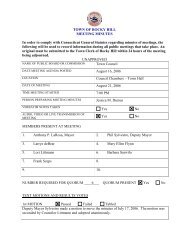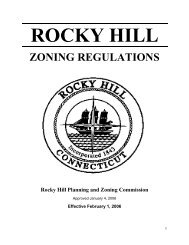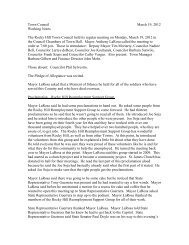Quarry Park - Town of Rocky Hill
Quarry Park - Town of Rocky Hill
Quarry Park - Town of Rocky Hill
- TAGS
- quarry
- rocky
- rockyhillct.gov
Create successful ePaper yourself
Turn your PDF publications into a flip-book with our unique Google optimized e-Paper software.
<strong>Quarry</strong> Locations:<br />
1. Duke <strong>of</strong> Cumberland Inn: As you enter the <strong>Park</strong>, you will see a substantial brick house. When it was built, it was unique in its elegance and convenience.<br />
Throughout its life, it has served many purposes; one <strong>of</strong> which was that <strong>of</strong> a tavern. During that period, it is said George Washington stopped by there.<br />
2. 1936 Buick: Following the Blue Trail, you are proceeding along an old roadway into the quarry. On this trail you will find the rusty remains <strong>of</strong> an old 1936<br />
Buick that had been set-up to run a ski tow. The club that used it was organized in 1948, at which time the hillside was devoid <strong>of</strong> trees.<br />
3. Soldiers’ Camp: If you continue along the Blue Trail, you come eventually to the <strong>Quarry</strong> <strong>Park</strong> lookout. When you do, you will have passed the location where a<br />
small U.S. Army encampment had been in 1942 at the start <strong>of</strong> WWII. Stationed here, the soldiers maintained searchlights and listening devices to protect from<br />
possible air raids on Pratt &Whitney Aircraft or Colt’s Patent Firearm plants in the Hartford area.<br />
4. Lookout: A part <strong>of</strong> the Blue Trail, this location is one <strong>of</strong> the Northern most areas <strong>of</strong> the <strong>Quarry</strong>. Elevated and largely unobstructed by trees, it provides an<br />
excellent view <strong>of</strong> the area, including Glastonbury and the Meadows.<br />
5. Phragmites Pond: Looking down into the <strong>Quarry</strong> from the ridge, you can see a large pond that is filling in with the invasive species Phragmites. Before they<br />
arrived, the pond had been inhabited by many animals; as cattails grew on the banks and provided a ready food source. Next to this pond, is a smaller, deeper pond<br />
that served as a swimming area. Before being tested and found polluted, it had had a makeshift diving board to take advantage <strong>of</strong> its depth.<br />
6. Connecticut Gun Guild: At the base <strong>of</strong> the ridge where the Lookout is best, the Connecticut Gun Guild had a target range in the late 1940’s. Here, they fired a<br />
variety <strong>of</strong> firearms using the rock wall as an effective backstop for any fired rounds.<br />
7. Cement Pilings: Continuing south on the Blue Trail, and a short way beyond the pond on your left, there are some low cement pilings. In this area there had<br />
once been a forge and blacksmith shop, in addition to a water tower. Below and to the south <strong>of</strong> this location, the <strong>Rocky</strong> <strong>Hill</strong> Vault Co. had its business in 1947.<br />
Latter, from 1960 to 64, the <strong>Rocky</strong> <strong>Hill</strong> Public Works parked equipment there.<br />
8. Aircraft Tower: On the high ridge at the south end <strong>of</strong> the quarry excavation area is where the aircraft-spotting tower was located during World War II.<br />
Maintained by citizens <strong>of</strong> both <strong>Rocky</strong> <strong>Hill</strong> and Wethersfield, it watched for possible enemy aircraft 24-hours a day. Near here was the Shipman’s Tavern, well<br />
known for parties and balls.<br />
9. Compressor House: Used in the thirties, and perhaps the late twenties this location was used as the housing for air compressors. Running the pressurized air iron<br />
pipes, these compressors were used to power the drills up top, in order to mine the stone. It was taken apart in the fifties, when the mine closed.<br />
10. Secondary Crusher: Of the other locations, this is the largest. Encompassing both the concrete structure at the base <strong>of</strong> the hill and the pillars further down the<br />
trail, it would further crush up the mined rock. From there, it would load up the pulverized stone onto the nearby trains, then distributed to buyers.











